UNCW - Servicing Exhaust Systems In Research Facilities
advertisement
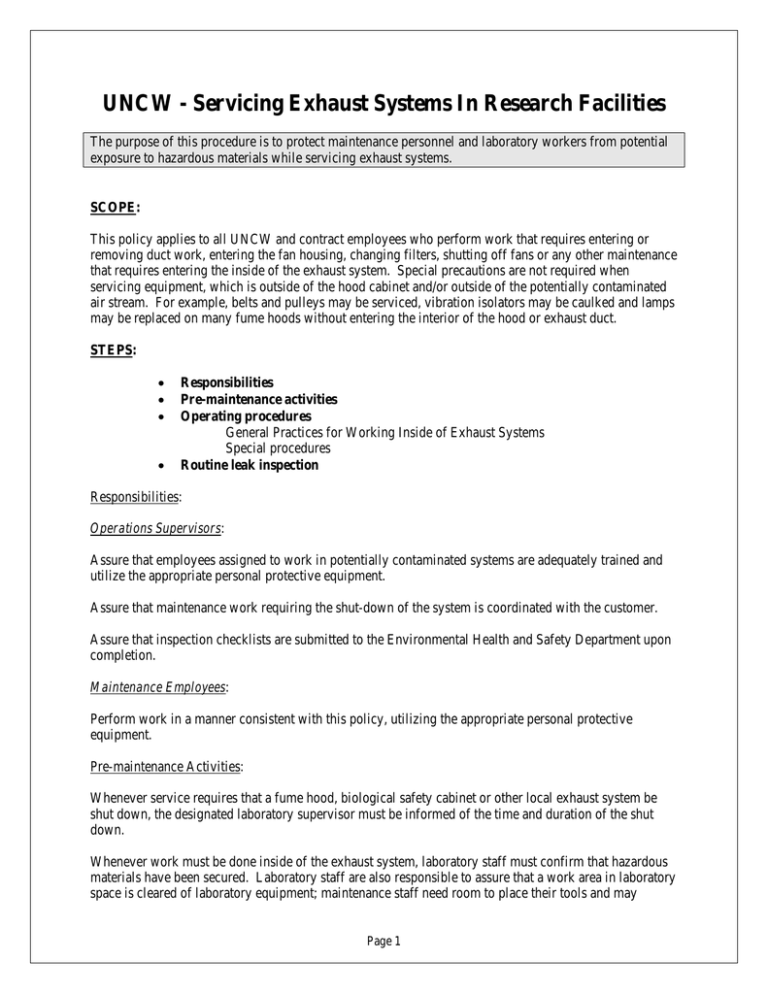
UNCW - Servicing Exhaust Systems In Research Facilities The purpose of this procedure is to protect maintenance personnel and laboratory workers from potential exposure to hazardous materials while servicing exhaust systems. SCOPE: This policy applies to all UNCW and contract employees who perform work that requires entering or removing duct work, entering the fan housing, changing filters, shutting off fans or any other maintenance that requires entering the inside of the exhaust system. Special precautions are not required when servicing equipment, which is outside of the hood cabinet and/or outside of the potentially contaminated air stream. For example, belts and pulleys may be serviced, vibration isolators may be caulked and lamps may be replaced on many fume hoods without entering the interior of the hood or exhaust duct. STEPS: • • • • Responsibilities Pre-maintenance activities Operating procedures General Practices for Working Inside of Exhaust Systems Special procedures Routine leak inspection Responsibilities: Operations Supervisors: Assure that employees assigned to work in potentially contaminated systems are adequately trained and utilize the appropriate personal protective equipment. Assure that maintenance work requiring the shut-down of the system is coordinated with the customer. Assure that inspection checklists are submitted to the Environmental Health and Safety Department upon completion. Maintenance Employees: Perform work in a manner consistent with this policy, utilizing the appropriate personal protective equipment. Pre-maintenance Activities: Whenever service requires that a fume hood, biological safety cabinet or other local exhaust system be shut down, the designated laboratory supervisor must be informed of the time and duration of the shut down. Whenever work must be done inside of the exhaust system, laboratory staff must confirm that hazardous materials have been secured. Laboratory staff are also responsible to assure that a work area in laboratory space is cleared of laboratory equipment; maintenance staff need room to place their tools and may Page 1 occasionally need room to place a ladder. NOTE: Physical Plant maintenance employees shall not remove, alter, or move laboratory equipment, or chemicals. Laboratory staff are responsible these items. Immediately before an exhaust system will be shut down, the sign shown in Appendix A must be placed on the sash of the fume hood. If the exhaust system being serviced provides ventilation for an entire room, this sign must also be placed on the door to the room. Some work inside an exhaust system may be accomplished without shutting it down. However, hazardous chemicals must be secured and the fume hood cleared so that work can be safely performed. Some examples of work inside the exhaust system that can be done while the fume hood is running include: replacing lamps, cleaning behind fume hood baffles or replacing airflow censors. Operating Procedures: General Practices for Working Inside of Exhaust Systems: Wear the following personal protective equipment: minimum respiratory protection of a P 99 dust mask, nitrile or rubber gloves, chemical goggles and tyvek coveralls. Perform necessary maintenance Dispose of coveralls and wash the outside gloves or dispose of gloves. Remove mask and gloves; then wash hands and face. Special Operating Procedures: Radioisotope Hoods: Whenever working on the inside of a fume hood cabinet posted with a “Caution Radioactive Materials” sign, contact the Environmental Health & Safety (EH&S), Radiation Safety Officer (RSO) and request a survey to certify that hood contamination is below applicable standards. Use the flowchart (Appendix B) to determine if RPD should be contacted to perform a survey. Following the survey, EH&S staff will post the hood with the notice shown in Appendix B. If contamination is below applicable standards the general practices outlined above shall be used. If contamination is above applicable standards, the RPD representative will specify special procedures. Perchloric Acid Hoods: Contact Environmental Health & Safety (EH&S). The hood will be tested for the presence of perchlorates. If perchlorates are not present, proceed under general practices as outlined above. If perchlorates are present, the hood must be washed down with water until the levels are acceptable. After safe levels are reached, proceed under general practices as outlined above. Page 2 Biological Safety Cabinets: Biological safety cabinets are to be maintained and serviced by a NSF certified contractor. Replacement/Repair of HEPA or Charcoal Filters: Follow the general practices as outlined above. For removal of these filters, follow the precautions and procedures listed below: At least the following equipment will be required: ladder, duct tape, large U of MN #21058 poly bag, and screwdrivers, pliers and adjustable wrench. Notify lab of required maintenance, tag out hood, then turn off the fume hood fan. Put on protective equipment. Remove the filter access panel and place in a bag. Verify that filter locking devices are loosened. Attach the large #21058 bag around the filter access panel opening, in a manner that seals the filter access opening, using duct tape or elastic cord. Remove the pre-filter by grasping the filter from outside the bag (with the bottom of the bag) and pull it into the bag. Pull the HEPA filter into the bag in the same manner. NOTES: • Charcoal filters are heavy when compared to a HEPA filter. Because a used charcoal filter can weigh 100 pounds, you may require assistance to remove it. • In some cases, it may be necessary to remove the bag with the prefilter and tape a second bag to the access panel for removal of the HEPA filter. Remove the bag from the duct work, then seal the bag shut with tape, leave the bag on the lab floor near the fume hood. Replace the access panel(s). Restart the fume hood fan. Reassemble the fume hood. Any tools that have had contact with the interior of the filter enclosure should be placed in a bag by filter and EH&S will survey them. Clean up any dust or debris outside of the fume hood with wet paper towels and place them in a bag. Then remove coverall, respirator and gloves and place them in a bag. Wash hands when job completed. Contact EH&S to clear the filters that were removed from the fume hood. Page 3 EH&S will contact the Physical Plant to have them remove the filters to a dumpster if the item was cleared for disposal. If not cleared for general disposal, EH&S staff will remove the filters for special disposal. The fume hood system must be rebalanced to assure that face velocities are between 90 and 110 feet per minute. When completed, the Physical Plant will notify EH&S that the system has been balanced. Also, notify lab staff and remove tag out posting upon completion of the job. Do not replace filters in fume hood ducts unless directed to do so by EH&S staff. Repair of Heat Recovery Coils: Follow the general practices as outlined above. Pre-filters must be carefully removed and placed into heavy polyethylene bags. The bags must be taped shut and placed in the general waste stream. Routine Leak Inspection: Inspect the fan housing, vibration isolator and the positive pressure duct work for leaks. Seal minor leaks that have been identified NOTE: If you are not able to seal the leaks, notify EH&S and note the duct work condition. Page 4

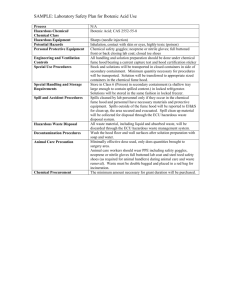
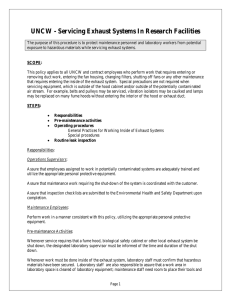
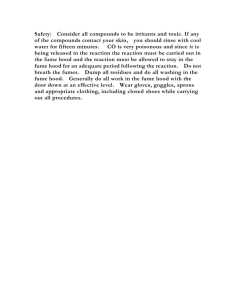

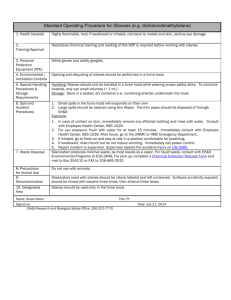
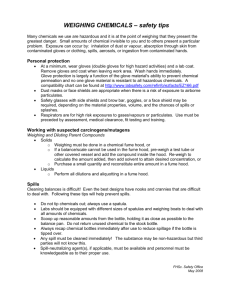
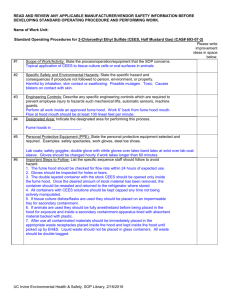
![Safety%20Step%20by%20Step[1]. - thsicp-23](http://s3.studylib.net/store/data/009097871_1-7065ff837c3ce091dcdb4239bcbcbee5-300x300.png)